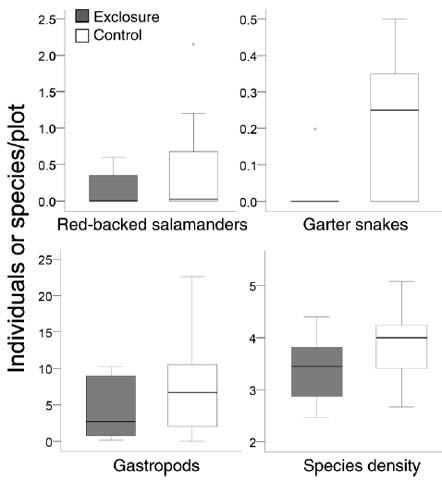Katherine R. Greenwald, Lisa J. Petit, Thomas A. Waite (2008). Indirect Effects of a Keystone Herbivore Elevate Local Animal Diversity Journal of Wildlife Management, 72 (6):1318-1321.
DOI: 10.2193/2007-491
Whether or not increased deer populations negatively affect terrestrial gastropod abundances and diversities was the subject of this post back in December 2005 and a subsequent note I published in Tentacle, No. 14 (starting on p. 20). Two published studies had claimed to show that overabundance of deer was reducing the numbers of some species of terrestrial mollusks. My main criticisms of those studies were that they had methodological limitations and interpretational problems.
This recent study by Greenwald et al. provides some evidence that having lots of while-tailed deer (Odocoileus virginianus) in a park may not be a bad thing after all.
The authors counted salamanders, snakes and various invertebrate taxa in 12 10x10-m enclosures from which while-tailed deer were excluded and in 12 control plots that were freely accessible to deer. The study took place in Cuyahoga Valley National Park in Ohio in 2004 and 2005, approximately 5 years after the enclosures were established.
The results show that red-backed salamander (Plethodon cinereus), garter snake (Thamnophis sirtalis) and gastropod abundance as well as invertebrate richness (no. of species or higher level taxa) were higher in control than in exclosure plots.

Fig. 1 from Greenwald et al. The thick line across each box is the median of means for over the entire study period.
So far, so good. The increased abundances of gastropods in plots grazed by deer seem to support my contention that in North American forests where the white-tailed deer coevolved with the other native inhabitants, any impact the deer present at normal or near normal population densities might have on the other native inhabitants would be a natural process and not necessarily be detrimental to them. However, my initial excitement was short-lived.
As far as gastropods are concerned, this study had a serious flaw: the counted gastropods were listed only as "slugs" without further identifications. This is a shame, because slugs are rather easy to identify by experienced workers at least to genera from external characteristics. Such identifications can be done even from good photographs. Had the authors sent out identification requests to the land snail community, I am sure they would not have been turned down.
Without additional information on what those "slugs" were, the results of this study don't have much relevance for terrestrial gastropod research. Were those slugs introduced or native? That's a crucial distinction in terms of gastropod conservation and even the genus-level identifications of the slugs would have been of great value.
What really matters is to know if native terrestrial gastropod species benefit from deer grazing. I hope somebody will undertake a better study to look into that. We also need a mechanistic explanation of how deer abundance may affect the populations of coexisting animals.
Many thanks to Katy Greenwald for sending me a pdf copy of her paper and for providing clarifications about the study.
Source
No comments:
Post a Comment